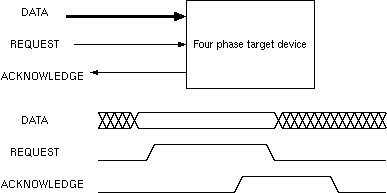HOME
UP
PREV
NEXT (Practical Bus Protocols on IP Blocks)
Classes of On-Chip Protocol

- Reciprocally-degrading: such as handshake protocols studied earlier: throughput is inversely proprotional to target latency in terms of clock cycles,
- Delay-tolerant: such as AXI-lite and OCP's BVCI (below): new commands may be issued while awaiting responses from earlier,
- Reorder-tolerant: such as full AXI: responses can be returned in a different order from command issue: helpful for DRAM access and needed for advanced NoC architectures.
- Virtual-circuit: (beyond scope of this course): rather than putting a destination address and port number in each message, traffic is routed at each hop via a short circuit identifier (or routing tag) where mappings have been set up in advance in the routing nodes.
- Separated send and acknowledge circuits:
A decoupling between send and reply or send and acknowledge, perhaps using a priority mechanism or perhaps using physical separation of the two directions of flow, exists, to ensure responses can always be returned, hence avoiding a form of deadlock.
- Credit flow controlled: (beyond scope of this course): each source has a credit counter
per destination or per destination/port number pair, controlling how many packets it can send without receiver buffer over-run.
Lables or tags need to be added to each transaction to match up commands with responses.
The EACD+ARCH part Ib classes use the 'Avalon' bus on the Altera devices:
»Avalon Interface Specifications
For those interested in more detail:
»Comparing AMBA AHB to AXI Bus using System Modelling

